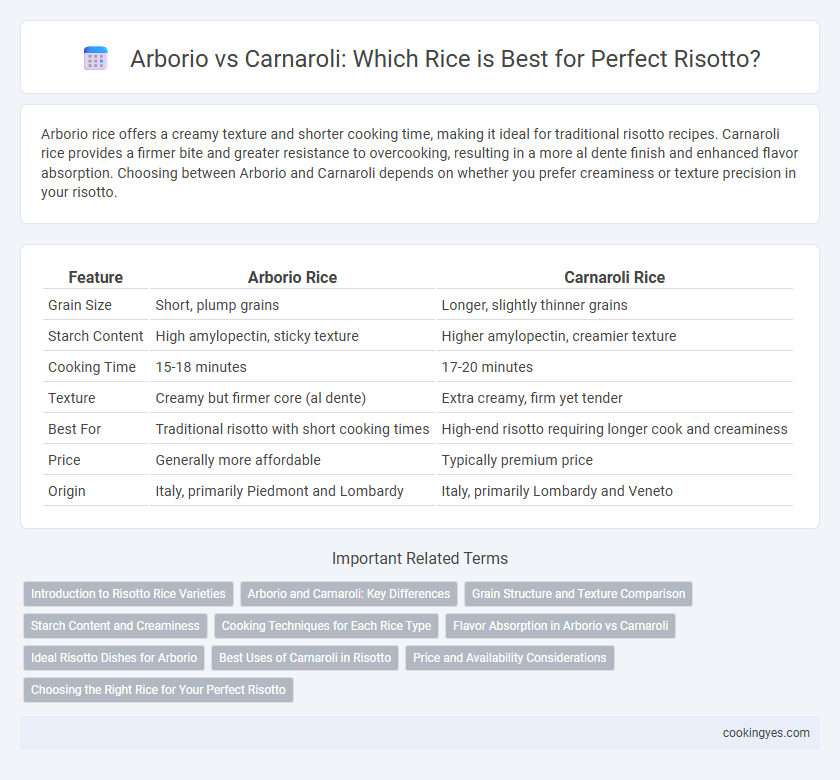Arborio rice offers a creamy texture and shorter cooking time, making it ideal for traditional risotto recipes. Carnaroli rice provides a firmer bite and greater resistance to overcooking, resulting in a more al dente finish and enhanced flavor absorption. Choosing between Arborio and Carnaroli depends on whether you prefer creaminess or texture precision in your risotto.
Table of Comparison
| Feature | Arborio Rice | Carnaroli Rice |
|---|---|---|
| Grain Size | Short, plump grains | Longer, slightly thinner grains |
| Starch Content | High amylopectin, sticky texture | Higher amylopectin, creamier texture |
| Cooking Time | 15-18 minutes | 17-20 minutes |
| Texture | Creamy but firmer core (al dente) | Extra creamy, firm yet tender |
| Best For | Traditional risotto with short cooking times | High-end risotto requiring longer cook and creaminess |
| Price | Generally more affordable | Typically premium price |
| Origin | Italy, primarily Piedmont and Lombardy | Italy, primarily Lombardy and Veneto |
Introduction to Risotto Rice Varieties
Arborio and Carnaroli are the two most popular rice varieties used in risotto, each with distinct characteristics suited for creamy, perfectly textured dishes. Arborio rice features a high starch content and shorter, plumper grains, providing a creamy texture but with a slightly softer bite. Carnaroli rice, often called the "king of risotto rice," has larger grains and higher amylose content, which offers superior absorption and a firmer, al dente texture prized by professional chefs.
Arborio and Carnaroli: Key Differences
Arborio rice grains are shorter and plumper, offering a creamier texture with a slightly firmer center, ideal for traditional creamy risotto dishes. Carnaroli rice grains are longer, known as the "king of rice," prized for their superior starch content that delivers a silkier, more al dente consistency and better resistance to overcooking. Both varieties provide essential starch for risotto's signature creaminess, but Carnaroli's higher amylose content ensures more controlled absorption and a refined texture preferred by chefs.
Grain Structure and Texture Comparison
Arborio rice features a shorter, plumper grain with a high starch content that yields a creamy, slightly chewy texture ideal for classic risotto. Carnaroli grains are longer and firmer with a superior starch composition, providing a creamier consistency while maintaining a distinct al dente bite. The denser grain structure of Carnaroli enhances its ability to absorb liquids and release starch gradually, resulting in a more delicate, refined texture compared to Arborio.
Starch Content and Creaminess
Arborio rice contains a high starch content that contributes to its characteristic creamy texture, making it ideal for traditional risotto dishes. Carnaroli rice has an even higher starch level, offering superior creaminess and a firmer, more al dente bite, preferred by chefs seeking a perfect balance of richness and texture. The choice between Arborio and Carnaroli significantly impacts the risotto's creaminess and mouthfeel due to their distinct amylopectin concentrations.
Cooking Techniques for Each Rice Type
Arborio rice, known for its high starch content, requires constant stirring and gradual broth addition during cooking to achieve a creamy risotto texture. Carnaroli rice, often preferred by chefs, retains its shape better and benefits from a gentler cooking process with slightly less stirring, allowing the grains to maintain firmness without becoming mushy. Mastering these cooking techniques ensures optimal creaminess and texture tailored to the distinct absorption properties of Arborio and Carnaroli rice.
Flavor Absorption in Arborio vs Carnaroli
Arborio rice absorbs flavors quickly due to its higher amylopectin content, resulting in a creamier, slightly stickier risotto texture. Carnaroli rice retains its shape better during cooking and absorbs flavors more evenly, offering a balanced taste with a firmer bite. The choice between Arborio and Carnaroli depends on whether a richer creaminess or a more refined texture with distinct grain integrity is preferred.
Ideal Risotto Dishes for Arborio
Arborio rice, characterized by its short grains and high amylopectin content, is ideal for creamy risotto dishes like Risotto alla Milanese and mushroom risotto due to its ability to release starch and create a velvety texture. It absorbs flavors well, making it perfect for recipes that require infusion of broth, saffron, or wine. While Carnaroli offers firmer grains and longer cooking tolerance, Arborio is preferred for classic, quick-cook risottos where creaminess and flavor integration are paramount.
Best Uses of Carnaroli in Risotto
Carnaroli rice is prized for its firm texture and high starch content, making it ideal for creamy, rich risottos that hold their shape well through slow cooking. Its ability to absorb flavors while maintaining a slightly al dente bite distinguishes it from Arborio, which tends to be creamier and softer. Chefs prefer Carnaroli when preparing risottos that require precise texture control, such as seafood risottos or those featuring bold, delicate ingredients.
Price and Availability Considerations
Arborio rice is more widely available and generally lower in price compared to Carnaroli, making it a popular choice for everyday risotto recipes. Carnaroli, often referred to as the "king of rice," commands a higher price due to its superior starch content and creamier texture, but it may be harder to find in regular supermarkets. For budget-conscious cooks or those with limited access, Arborio offers a cost-effective option without compromising the essential risotto experience.
Choosing the Right Rice for Your Perfect Risotto
Arborio and Carnaroli are the top rice choices for making the perfect risotto due to their high starch content, essential for a creamy texture. Arborio rice offers a slightly softer, creamier consistency while Carnaroli is firmer with a more al dente bite, preferred by many chefs for better texture retention. Selecting Carnaroli enhances the risotto's ability to absorb flavors without becoming mushy, making it ideal for refined, restaurant-quality dishes.
Arborio vs Carnaroli for rice selection Infographic

 cookingyes.com
cookingyes.com